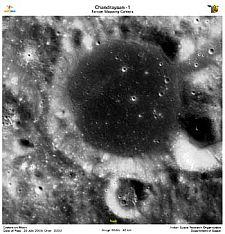 | « Back to article | Print this article |
India completes design of Chandrayaan-2
 India has completed the design of Chandrayaan-2, its next mission to the moon -- this time in collaboration with Russia -- that would have a lander and rover that can collect samples of the lunar soil and analyse them and send back the data.
India has completed the design of Chandrayaan-2, its next mission to the moon -- this time in collaboration with Russia -- that would have a lander and rover that can collect samples of the lunar soil and analyse them and send back the data.
"Right now, the design has been completed. We had a joint review with Russian scientists in Bengaluru," Chairman of Indian Space Research Organisation, G Madhavan Nair, told PTI.
According to the Bangalore-headquartered space agency, the Chandrayaan-2 mission would have an orbital flight vehicle constituting an Orbital Craft and a Lunar Craft that would carry a soft landing system up to Lunar Transfer Trajectory.
The target location for the lander-rover would be identified using data from instruments of Chandrayaan-1, India's own and first unmanned mission to the Moon launched on October 22 last year.
While ISRO will be developing the orbiter, it will be Russia's job to make the lander and rover. Additional scientific payloads would be acquired from international scientific community.
"Next (now that design has been completed) we will go towards prototype building, which will be taken up next year," Nair, also secretary in the Department of Space, said.
Nair said ISRO has learnt plenty of lessons from Chandrayaan-1 mission, particularly on the thermal and redundancy management fronts and would seek to improve systems in Chandrayaan-2, slated towards the end of 2012.
"I think we have got very valuable inputs on the heat radiation from the moon's surface and so on. Accordingly, the thermal design of the future aircraft can be addressed," he said.
"Radiation is much beyond our expectations, so we will have to see how the radiation hardening has to be strengthened."
"Then, in redundancy management also, there are some inputs which are available from this (Chandrayaan-1), which we will try to incorporate in Chandrayaan-2."
The ISRO Chairman said contingency operations undertaken by the organisation following the failure of Chandrayaan-1 spacecraft's onboard star sensor earlier this year have worked well and "this is (now) as precise as it was earlier."
"We are able to locate the cameras at specific locations," he said noting some of the stereo images that have come recently.
"The fact that we were able to point the spacecraft towards the Earth and capture the (recent) solar eclipse, shows the accuracy of the system."
Nair said 95 per cent of the scientific objectives of Chandrayaan-1 mission have been achieved. "Another five per cent, what's left out, we will try to take up in the next season which is starting in October so that we can complete all the observations."
Image: Picture showing details of the Leibniz crater on the moon taken by Chandrayaan-1